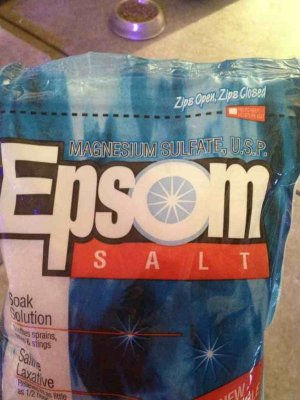zeroinverse
New member
Just thought I'd share info with the members...
http://en.wikipedia.org/wiki/Dolomite
(I'll explain why dolomite further down)
Magnesium (Mg) ions is a critical part of keeping our fish tanks happy.
As Grant mentioned in another thread, low magnesium makes it hard to stabilize your Calcium concentrations. This is because magnesium fills "holes" on calcium carbonate surfaces, preventing more calcium from attaching to your live rock. This means more calcium ions stay in the water column for your corals to extract. That is how you can increase your calcium concentrations by having high magnesium levels.
High magnesium levels are also good to prevent/starve brysopsis (spelling?) algae.
=========
Dolomite is often used in calcium reactors because it is a Calcium-Magnesium-Carbonate. This dissolves in the reactor and helps to add magnesium into your tank water.
Read in the Wikipedia article about how dolomite forms. It's pretty interesting. Layers of "sulphate-producing bacteria" is one way (like in deep sand beds), and also in areas of volcanic underwater channels where calcium & magnesium concentrations help the formation.
http://en.wikipedia.org/wiki/Dolomite
(I'll explain why dolomite further down)
Magnesium (Mg) ions is a critical part of keeping our fish tanks happy.
As Grant mentioned in another thread, low magnesium makes it hard to stabilize your Calcium concentrations. This is because magnesium fills "holes" on calcium carbonate surfaces, preventing more calcium from attaching to your live rock. This means more calcium ions stay in the water column for your corals to extract. That is how you can increase your calcium concentrations by having high magnesium levels.
High magnesium levels are also good to prevent/starve brysopsis (spelling?) algae.
=========
Dolomite is often used in calcium reactors because it is a Calcium-Magnesium-Carbonate. This dissolves in the reactor and helps to add magnesium into your tank water.
Read in the Wikipedia article about how dolomite forms. It's pretty interesting. Layers of "sulphate-producing bacteria" is one way (like in deep sand beds), and also in areas of volcanic underwater channels where calcium & magnesium concentrations help the formation.
Coral atolls
Dolomitization of calcite also occurs at certain depths of coral atolls where water is undersaturated in calcium carbonate but saturated in dolomite. Convection created by tides and sea currents enhance this change. Hydrothermal currents created by volcanoes under the atoll may also play an important role.
Dolomitization of calcite also occurs at certain depths of coral atolls where water is undersaturated in calcium carbonate but saturated in dolomite. Convection created by tides and sea currents enhance this change. Hydrothermal currents created by volcanoes under the atoll may also play an important role.

